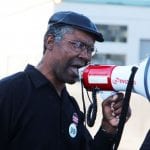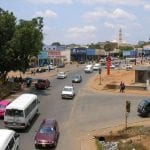Education not incarceration is the battle cry of a new campaign of the Black Radical Congress, a national coalition of progressive African Americans. At its June national organizing conference in Detroit, the two-year-old organization launched its first national campaign to call attention to and change the education and criminal justice systems. “Black youth today, along with other youth of color, are being tracked from school to jail as a matter of public policy,” the BRC says. Local chapters of the BRC will develop research, education, organizing, and action strategies during the campaign.
* * *
At least 27,000 squatter-families living along Philippine National Railway tracks from Metro Manila to the former U.S. Air Force Base at Clark Field will not leave their homes until an ”on-site, in-town relocation” plan is developed for them, the Philippine Daily Inquirer reports, citing an urban poor activist group. The squatters live along the proposed Manila-Clark Rapid Railways System. The government calls this proposed 100 km rail link a vital piece of plans to build a new international airport at Clark and to continue resort, commercial, and industrial development at the site. The rail, which would connect to Manila’s light-rail system, would cut travel time from three hours to one hour. Representatives of the urban poor complain that government relocation plans are inadequate and expensive, offering limited housing at a remote location too far from employment opportunities.
* * *
Writing in the American Prospect, economists Dean Baker and Jim Barrett advocate pay-by-the-mile auto insurance as an alternative driving disincentive to unpopular gasoline tax hikes. According to Baker and Barrett, selling insurance on a per-mile basis would provide an equivalent disincentive to a $1.50 per-gallon gas tax and reduce miles driven by 10 to 20 percent. They base their projections on a 7.5 cents per-mile rate for the average, generally safe driver. “The predicated reduction in miles driven should be sufficient to bring about half of the emissions reduction needed in the transportation sector under the Kyoto agreement,” Baker and Barrett contend.
* * *
Rave and municipal politics? In Toronto, previously apolitical kids turned out this summer to fight for what they see as their right to dance the night away. According to Toronto’s Now newsweekly, ravers have been transformed “from a subculture who loved their scene but had little or no willing relations with the media and the authorities into a savvy, slick, grassroots, networked machine, complete with their own press releases, advocacy groups and growing alliances with other communities.” Sparking this political awakening was a city council proposal to ban raves on city property. The attack on raves followed earlier moves against the homeless and squeegee men, raising debate over who municipal government is to serve. The more immediate question is: Will the party kids stay awake or return to their political slumber once the city council reaches its decision?
* * *
Missoula appears to be leading the way from complete automobile reliance to a more diverse transportation mindset. Government agencies and nonprofits in the Montana college town are developing bike paths, giving away bicycles, adding bike racks to buses, increasing bus service hours, and encouraging walking. According to the Missoula Independent, government agencies are providing both dollars and designs to make the Missoula Valley a functional and pleasant hub for bicyclists and a model of efficient transportation systems for communities around the world. Local officials put Missoula in the top five cities nationally in promoting transit and nonmotorized transportation, but the city’s programs have foes. This summer, a city council member proposed abolishing four of Missoula’s alternative transportation programs.
* * *
The future of Jerusalem remains a sticking point in attempts by Israeli and Palestinian peace advocates to craft a lasting settlement to the long-standing conflict between the two peoples. During the recent Camp David peace talks, Israeli Prime Minister Ehud Barak and Palestinian President Yassir Arafat failed to reach an agreement over the ancient city’s future, but new ideas were at least put on the table. The sticking point is major: Palestinian people and leaders are demanding sovereignty over at least part of the city while Barak, who is under considerable political pressure to deny such claims, has been willing to offer limited autonomy over Arab sections of the city and Muslim holy sites. Writing for the Transnational Foundation for Peace and Future Research, columnist Jonathan Powers suggests a way out of the impasse. Powers recommends a period of international control of Jerusalem’s heart, during which time Israeli and Palestinian nations learn to live side-by-side as neighbors.
* * *
Traditional housing policy is ill equipped to solve the housing-related problems confronting communities throughout the United States. That’s the position taken by the National Multi-Housing Council and the National Apartment Association as they launch an advocacy campaign in support of “a more balanced national housing policy.” The organizations, which represent apartment builders, owners, financiers, and managers, are urging policy-makers to abandon their “almost exclusive focus on home ownership and concentrate instead on ensuring that all Americans have access to decent and affordable housing, regardless of whether they rent or own.”
* * *
Any list of the men most responsible for today’s suburban sprawl would have to include the name Eli Broad. As a founding partner in Kaufman & Broad made a fortune building undistinguished tract housing through much of the United States. Now, the Los Angeles Times reports, Broad is a prime mover behind the development of the urban core of the nation’s second city. The 67-year-old chairman of SunAmerica insurance is pumping energy and fortune into the revitalization of a downtown L.A. gutted by the very suburbanization that made Broad a rich man. “It’s a paradox,” Broad says of his newfound urbanism. “The costs of urban sprawl are very expensive. We’ve got to build closer in, higher densities, and do whatever is necessary to save the farmland.”
* * *
What is America’s most mobbed-up city? That question could stir some keen debate amongst political scientists and Court TV fans, but journalists have recently nominated a pair of small, down-on-their-their luck rust belt cities: Camden, New Jersey, and Youngstown, Ohio. Camden attracted attention recently when the state, acting on Gov. Christine Whitman, put the city under supervision, taking over the finances and some operational management of what some call the nation’s second poorest city. The state’s move followed the indictment of Mayor Milton Milan on federal corruption charges. The indictment came after a former mob boss said he gave the mayor at least $30,000 in bribes in return for special treatment for businesses tied to organized crime. The mob also figures in Youngstown’s troubles. According to the New Republic, Youngstown is the most “crooked city in America.” Located in one of the most depressed corners of America, Youngstown’s middle class has all but disappeared, the magazine says, its civil society has been replaced by the mob. At the political center of the Youngstown story is U.S. Rep. Jim Traficant (D-Ohio) who, despite an FBI investigation and apparently impending indictment, is favored to win a ninth term in Congress. Traficant is not taking the matter sitting down. “I will be presenting evidence to Congress to prove that the FBI has been on the mob’s payroll and doing the mob’s bidding for the past 40 years,” Traficant said after an associate was indicted earlier this year. “No matter what happens to me, the FBI will have to answer for labeling Youngstown a whorehouse.”
* * *
The Urban Institute, a nonprofit research organization based in Washington, D.C., is managing a one-year pilot project to give 150 families certificates to buy vacant permanent housing in Gyumri, the largest city destroyed by a massive earthquake in Armenia in 1988. The families have been living in temporary shelters since the earthquake, and the lack of permanent housing accounts for much of the city’s deterioration. As temporary shelters are vacated and cleared, urban renewal efforts will begin.The U.S. Agency for International Development (USAID) selected the Urban Institute to design the program and offer technical assistance to the program’s administrators. In addition, two Armenian banks have been selected to facilitate all real-estate transactions, which will develop local capacity in financial and real estate sectors. USAID has contributed $1.5 million to the pilot, though with success the program may be expanded. In 1998, the Urban Institute, the Institute for Urban Economics in Moscow, and the Center for Policy Analysis at the American University of Armenia in Yerevan were commissioned by the World Bank to develop a strategy to meet the housing needs of families displaced by the 1988 earthquake. Armenia adopted the strategy, and over the past year USAID has worked closely with the Armenian government and other donors to develop and refine housing development models for the nearly 25,000 families still living in temporary shelters. The housing voucher pilot program reflects one housing development model. Other models provide lower-cost alternatives to new construction of permanent housing, including the reinforcement of buildings damaged by the earthquake and the renovation of temporary shelters in rural areas where residents have funding for land titles.
* * *
Describing cooperation between cities and suburbs as beneficial to all involved, the Detroit branch of the Metropolitan Organizing Strategy For Enabling Strength (MOSES), an interfaith alliance, announced plans to build metro area coalitions to lobby state and national legislators for better solutions to common problems. Religious leaders identified sprawl, transportation, funding inequities, and affordable housing as issues the coalitions could address, the Smart Growth Network reports. According to the Rev. Jerome Stevens of Detroit’s Renaissance Baptist Church described MOSES as a movement that could became a model for showing varied groups that “it benefits everyone to work together for our own self-interest.” Noting that jobs are moving farther out, but many people lack cars or the means to follow, Rev. Stan Ulman of Hamtramck’s St. Ladislaus Catholic Church said the rich move to expensive homes in suburbs, older neighborhoods lose tax dollars and “sprawl concentrates poverty and race.” Rev. Steve Jones of Birmingham’s First Baptist Church stressed that older suburbs are no less concerned about the lack of affordable and subsidized housing than cities.







